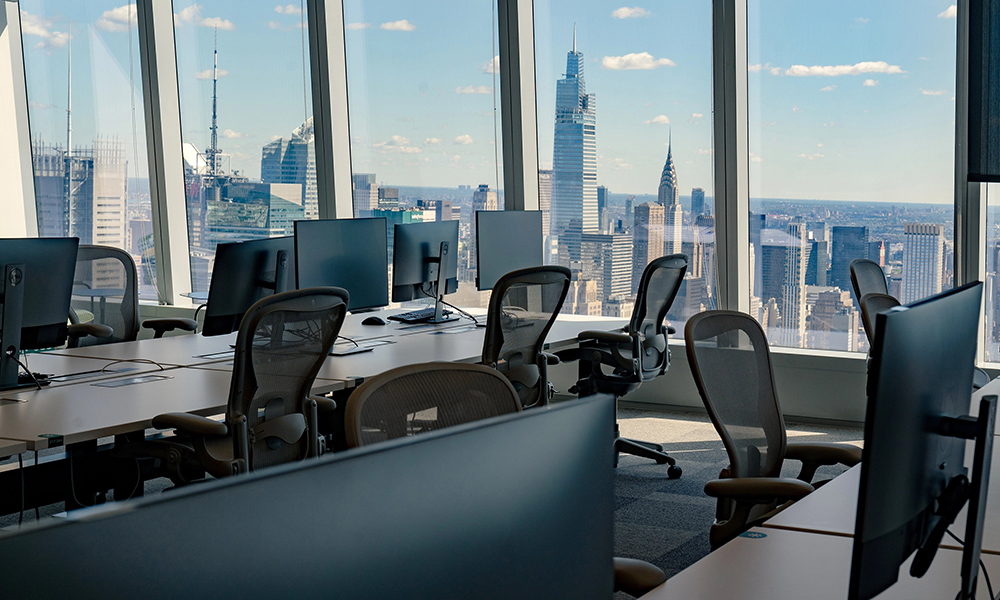
公司高管敦促員工重回辦公室,最終結(jié)果或許只能是喜憂參半——辦公室的工位依舊空了一半,?;蛘邠Q個(gè)說法,辦公室工位有一半是滿的,。
WFH Research的研究顯示,,雖然雇主希望員工重回辦公室,但只有49%的員工愿意每周五天到公司現(xiàn)場辦公,。Quartz at Work最先報(bào)道了這項(xiàng)研究結(jié)果,。約40%的上班族每周至少有一天依舊會(huì)遠(yuǎn)程辦公。他們表示,,如果雇主強(qiáng)制要求完全恢復(fù)現(xiàn)場辦公,,他們會(huì)選擇辭職或跳槽。
這是喬斯·瑪麗亞·巴雷羅,、尼布拉斯·布魯姆和史蒂芬·J·戴維斯的最新研究結(jié)果,。他們從2020年起,,每個(gè)月調(diào)查2,500至5,000名美國上班族對(duì)居家辦公的態(tài)度。5月的數(shù)據(jù)顯示,,強(qiáng)制員工重回總部辦公,,并非總是有效。遠(yuǎn)程辦公依舊受到追捧,,甚至在已經(jīng)收到最后通牒的上班族中也很受歡迎,。
巴雷羅告訴《財(cái)富》雜志:“經(jīng)過兩年多居家辦公之后,公司希望辦公室工作者以及至少可以遠(yuǎn)程完成部分工作的員工,,回到辦公室完全恢復(fù)現(xiàn)場辦公,,這是不現(xiàn)實(shí)的?!?/p>
但他還表示,,現(xiàn)場辦公依舊有其可取之處。巴雷羅表示,,現(xiàn)場辦公能夠增強(qiáng)協(xié)作,、溝通和決策,因此“相對(duì)較少的工作會(huì)繼續(xù)支持完全遠(yuǎn)程辦公,,盡管完全現(xiàn)場辦公在辦公室工作者中變得較為稀少,。”
這表明,,混合辦公是公司的致勝策略之一,。
兩全其美的做法
在這項(xiàng)結(jié)果公布時(shí),特斯拉(Tesla)CEO埃隆·馬斯克,、摩根大通(JPMorgan)CEO杰米·戴蒙和高盛(Goldman Sachs)CEO蘇德巍等,,都宣布計(jì)劃完全恢復(fù)現(xiàn)場辦公模式。
雖然馬斯克等CEO威脅將辭退不同意公司政策的員工,,但WFH Research調(diào)查的受訪者表示,,這類威脅只是空話。在被問到如果員工在辦公室辦公的天數(shù)少于公司規(guī)定,,雇主如何處理時(shí),,大多數(shù)受訪者(43.2%)表示雇主沒有任何動(dòng)作。有受訪者表示雇主確實(shí)威脅解雇員工,,但很少有人真得被解雇(只有6.3%),。
這可能是因?yàn)橥耆F(xiàn)場辦公模式越來越難找到合理的理由。當(dāng)員工的工作時(shí)間更靈活時(shí),,其工作效率更高,,而且混合辦公的員工表示,感覺與同事的聯(lián)系變得最為緊密,。蓋洛普(Gallup)2021年10月的一項(xiàng)調(diào)查顯示,,超過一半采取混合辦公模式的員工更喜歡這種模式,。
因此,混合辦公模式能夠更有效地說服更多員工重回辦公室,。WFH Research的調(diào)查發(fā)現(xiàn),,在希望員工每周四天在辦公室辦公的公司當(dāng)中,83.8%的員工已經(jīng)在按公司的要求執(zhí)行,。
谷歌(Google)和蘋果(Apple)等公司都注意到了這種趨勢,,并執(zhí)行了混合辦公計(jì)劃。巴雷羅表示:“自從兩年前開始研究項(xiàng)目以來,,越來越多雇主選擇制定疫情之后的混合辦公計(jì)劃,。”
在2020年,,可以居家辦公的員工對(duì)WFH Research表示,其雇主曾宣布員工在疫情之后可每周遠(yuǎn)程辦公約1.6天?,F(xiàn)在已經(jīng)延長到2.3天,。
研究人員之一的戴維斯表示,雇主想要員工每周五天坐在辦公桌前,,需要給出一個(gè)有吸引力的理由,。他表示:“想要員工開開心心地重回辦公室,老板要思考以下問題,,并給出一個(gè)具有說服力的答案:我已經(jīng)證明自己在家可以做好本職工作,,為什么每天還要在通勤上花30分鐘、60分鐘,,甚至90分鐘呢,?”(財(cái)富中文網(wǎng))
譯者:劉進(jìn)龍
審校:汪皓
疫情過后,只有半數(shù)員工會(huì)按公司的預(yù)期,,回到了辦公室,。攝影:AMIR HAMJA —— 彭博社/蓋蒂圖片社
公司高管敦促員工重回辦公室,最終結(jié)果或許只能是喜憂參半——辦公室的工位依舊空了一半,?;蛘邠Q個(gè)說法,辦公室工位有一半是滿的,。
WFH Research的研究顯示,,雖然雇主希望員工重回辦公室,但只有49%的員工愿意每周五天到公司現(xiàn)場辦公,。Quartz at Work最先報(bào)道了這項(xiàng)研究結(jié)果,。約40%的上班族每周至少有一天依舊會(huì)遠(yuǎn)程辦公。他們表示,,如果雇主強(qiáng)制要求完全恢復(fù)現(xiàn)場辦公,,他們會(huì)選擇辭職或跳槽,。
這是喬斯·瑪麗亞·巴雷羅、尼布拉斯·布魯姆和史蒂芬·J·戴維斯的最新研究結(jié)果,。他們從2020年起,,每個(gè)月調(diào)查2,500至5,000名美國上班族對(duì)居家辦公的態(tài)度。5月的數(shù)據(jù)顯示,,強(qiáng)制員工重回總部辦公,,并非總是有效。遠(yuǎn)程辦公依舊受到追捧,,甚至在已經(jīng)收到最后通牒的上班族中也很受歡迎,。
巴雷羅告訴《財(cái)富》雜志:“經(jīng)過兩年多居家辦公之后,公司希望辦公室工作者以及至少可以遠(yuǎn)程完成部分工作的員工,,回到辦公室完全恢復(fù)現(xiàn)場辦公,,這是不現(xiàn)實(shí)的?!?/p>
但他還表示,,現(xiàn)場辦公依舊有其可取之處。巴雷羅表示,,現(xiàn)場辦公能夠增強(qiáng)協(xié)作,、溝通和決策,因此“相對(duì)較少的工作會(huì)繼續(xù)支持完全遠(yuǎn)程辦公,,盡管完全現(xiàn)場辦公在辦公室工作者中變得較為稀少,。”
這表明,,混合辦公是公司的致勝策略之一,。
兩全其美的做法
在這項(xiàng)結(jié)果公布時(shí),特斯拉(Tesla)CEO埃隆·馬斯克,、摩根大通(JPMorgan)CEO杰米·戴蒙和高盛(Goldman Sachs)CEO蘇德巍等,,都宣布計(jì)劃完全恢復(fù)現(xiàn)場辦公模式。
雖然馬斯克等CEO威脅將辭退不同意公司政策的員工,,但WFH Research調(diào)查的受訪者表示,,這類威脅只是空話。在被問到如果員工在辦公室辦公的天數(shù)少于公司規(guī)定,,雇主如何處理時(shí),,大多數(shù)受訪者(43.2%)表示雇主沒有任何動(dòng)作。有受訪者表示雇主確實(shí)威脅解雇員工,,但很少有人真得被解雇(只有6.3%),。
這可能是因?yàn)橥耆F(xiàn)場辦公模式越來越難找到合理的理由。當(dāng)員工的工作時(shí)間更靈活時(shí),其工作效率更高,,而且混合辦公的員工表示,,感覺與同事的聯(lián)系變得最為緊密。蓋洛普(Gallup)2021年10月的一項(xiàng)調(diào)查顯示,,超過一半采取混合辦公模式的員工更喜歡這種模式,。
因此,混合辦公模式能夠更有效地說服更多員工重回辦公室,。WFH Research的調(diào)查發(fā)現(xiàn),,在希望員工每周四天在辦公室辦公的公司當(dāng)中,83.8%的員工已經(jīng)在按公司的要求執(zhí)行,。
谷歌(Google)和蘋果(Apple)等公司都注意到了這種趨勢,,并執(zhí)行了混合辦公計(jì)劃。巴雷羅表示:“自從兩年前開始研究項(xiàng)目以來,,越來越多雇主選擇制定疫情之后的混合辦公計(jì)劃,。”
在2020年,,可以居家辦公的員工對(duì)WFH Research表示,,其雇主曾宣布員工在疫情之后可每周遠(yuǎn)程辦公約1.6天。現(xiàn)在已經(jīng)延長到2.3天,。
研究人員之一的戴維斯表示,雇主想要員工每周五天坐在辦公桌前,,需要給出一個(gè)有吸引力的理由,。他表示:“想要員工開開心心地重回辦公室,老板要思考以下問題,,并給出一個(gè)具有說服力的答案:我已經(jīng)證明自己在家可以做好本職工作,,為什么每天還要在通勤上花30分鐘、60分鐘,,甚至90分鐘呢,?”(財(cái)富中文網(wǎng))
譯者:劉進(jìn)龍
審校:汪皓
The glass might finally be half full for executives pushing workers back to the office, but the office is still half empty. Or half full, depending on your perspective.
Only 49% of employees expected by their employer to return to the office are actually going in five days a week, according to a study from WFH Research, first reported by Quartz at Work. And around 40% of workers still working remotely at least one day per week said they'd quit or look for another job if their employer mandated a full-office return.
The findings are the latest from Jose Maria Barrero, Nicholas Bloom, and Steven J. Davis, who have been surveying 2,500 to 5,000 working Americans on work-from-home attitudes every month since 2020. May’s data revealed that forcing employees to come into headquarters isn’t always effective. Remote work still has traction, even among workers that have received ultimatums.
“After more than two years with a lot of working from home, it's not very realistic for companies to expect office workers, and those who can do at least part of their job remotely, back to the office full-time,” Barrero tells Fortune.
But, he adds, in-person work still has its merits. Due to the heightened ability to collaborate, converse, and make decisions, “relatively few jobs will remain fully remote, even as fully in-person work becomes rare among office workers,” Barrero says.
It's a sign that hybrid work is winning company policies.
The best of both worlds
The findings come at a time when CEOs like Tesla’s Elon Musk, JPMorgan’s CEO Jamie Dimon, and Goldman Sachs’ David Solomon all have announced their intention to return to a fully in-person work model.
While CEOs like Musk threaten to fire dissident employees, respondents to WFH Research’s poll said that the promises for consequence are empty. When asked how their employer responded to employees who worked in office fewer days than they were asked to, the majority of respondents (43.2%) said nothing happened. While some reported threats of termination occurred, very rarely was someone actually fired (only 6.3% of the time).
It's likely because fully in-person models have become harder to justify. Productivity has gone up among workers with more flexible schedules, and hybrid employees report feeling the most bonded with their coworkers. More than half of employees working a hybrid model prefer it, per a Gallup poll from October 2021.
It's why hybrid work policies are more successful at getting more people back in office. The WFH Research survey found that of companies expecting their employees to work in the office four days a week, 83.8% of workers are already following their employees’ requests.
Companies like Google and Apple have taken notice and implemented their own hybrid plans. “Since we started our research project two years ago, employers have increasingly switched to planning for a hybrid work scheme after the pandemic,” says Barrero.
Employees who could work from home told WFH Research in 2020 that their employers said they could work remotely about 1.6 days a week post-pandemic. Employers have since increased that to 2.3 days.
Davis, one of the researchers, says that employers need to give workers an enticing reason to be at their office desks five days a week. As he puts it, “For employees to return happily to the office, the boss needs a compelling answer to this question: Why must I spend 30, 60, 90 minutes a day on commuting, when I’ve shown I can do my job from home?”






